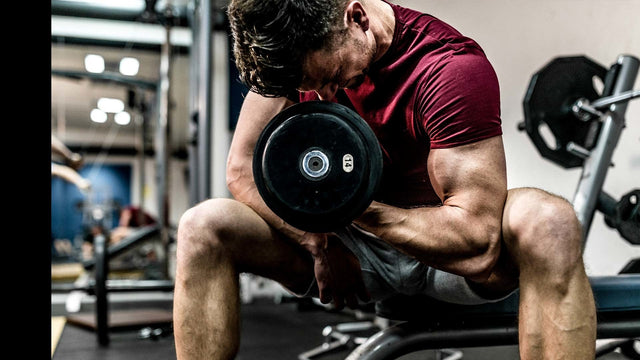There’s probably been a time in your training when you’ve thought to yourself, “how am I supposed to do this, I can’t even breath!”. Without proper breathing during exercise, your body doesn’t get the oxygen it needs to support what you’re asking it to do, leaving you weak and out of breath. Sucks, doesn’t it? We’re going to tell you how you can fix it in this quick and easy guide to breathing during exercise so that you can walk into the gym tomorrow, confident, informed, and ready to slay some weight. Let’s do this!
How Do You Know If You’re Breathing During Exercise Correctly?
The simple answer - when you’re able to continue at a sufficient pace without getting gassed. When you’re exercising or doing any activity, it’s essential to stay energized and efficient in your movement. Whether you’re trying to build mass muscle, lose body fat or weight, or crush an EMOM or WOD, the goal should be the same — to breathe as efficiently as possible to perform as best you can. Now, that’s a lot easier said than done. We'll get to breathing techniques later, but for now, it's important to understand the basic phrases that you will be breathing during as your starting point.
Eccentric vs Concentric Breathing - What's The Difference?
When lifting weights, each rep consists of a positive and a negative phase of work performed by the lifter on the bar. For this, we’ll take the squat for example.

Positive Phase aka Concentric Phase:
The positive phase is performed when a force is applied to a body, and the body moves in the direction of the applied force. In the squat, this is the initial move down into the squat, the concentric phase. This is when you’re going to inhale (concentric breathing).
Negative Work aka Eccentric Phase:
The negative phase is performed when a force is applied to a body, but the body moves opposite to the direction of the applied force, the eccentric phase. As you push down into the ground, your body moves upward away from it, contracting the muscles. This is when you’re going to exhale (eccentric breathing).
Activating Your Core
Your core is the group of muscles in the front and back of your midsection that stabilizes your spinal column to support the movements that you are expecting your body to do, safely.
The core is rooted in the diaphragm, a dome-shaped sheath of muscle fiber that sarges up into your rib cage. When you activate your core, we're not talking about just those pretty little muscles that make up your six-pack. We're talking more about using all components of your abdominal muscles to help you perform a series of movements with more oxygen, strength, and power.
Activating Your Inner Core
When you activate your inner core, it’s thanks to the diaphragm. Think of the diaphragm as your breathing muscle, so to speak. As you inhale, the top of the diaphragm in the lower half of your ribs lowers and flattens. As you exhale, the diaphragm rises, creating a tent-like shape. So why is this important?
Another way to look at it — you know those vacuums with the bags on them? They’re all flat, wonky looking, and easy to push around when they’re not plugged in, right? Then the moment you turn it on, the bag fills up super tight with air, and the whole vacuum becomes stabilized and sort of hard to push around? Your diaphragm is exactly like this during exercise!

When you take a deep inhale inward, the diaphragm flattens toward the bottom of your ribs, the intercostal muscles force your ribs to flare out, and there becomes more space in your diaphragm for your lungs to fill up with air (like the vacuum). When you exhale, just the opposite happens, the diaphragm releases and the ribs move back in, dispelling the air from the lungs.
When someone yells at you to activate your core through a movement, let’s say, a squat, what that simply means is before you go through the positive phase (squatting down) take that deep breath in, giving the lungs more room to breathe, squeezing those intercostal muscles tight, to stabilize your spine giving yourself more power and safety throughout the movement. As you go through the negative phase (standing back up), keeping those muscles tight, release the diaphragm, decompress the lungs, and return back to your starting point.
The Enemies of Breath During Exercise
Improper breathing during exercise leads to early exhaustion, fatigue, and poor performance. “Ain’t nobody got time for THAT!”. So what are you to do? Pay attention to your breathing and if you’re doing any of the following, fix it as quick as you can.
Breathing During Exercise Mistake #1: Shallow Breathing
Here’s a fun thought for you — most people go through their entire day without filling the lungs to their full capacity. Uh oh, this is a major problem! When you don’t practice deep breathing regularly throughout your day, and especially during intense exercise, the intercostal muscles of the diaphragm, just like any other muscle, get weak from disuse. Want a stronger core, more power, and better outcomes from your gym sesh? Breathe deeper, more often.
Breathing During Exercise Mistake #2: Holding Your Breath
Holding your breath during exercise can be beneficial at times, but for most people, holding your breath during exercise often means the early onset of fatigue and inefficiency. Whoops. Don’t short circuit your body’s natural rhythm and power of the breathing or you’ll be gasping for air far sooner than Janet over there lifting twice your weight. Just sayin’.
Breathing During Exercise Mistake #3: Tension
You should have tension on the bar, not in your breath. When you have tense breathing during exercise you actually work against the diaphragm and its full function. This means you inhibit the ribs from opening up and allowing that full space for the lower lobe of the lungs to move into, keeping you from breathing as deep as you can.
Breathing During Exercise Mistake #4: Not Fully Exhaling
Okay, so you think you breathe deep? Well, do you fully exhale? Probably not. When you don’t fully exhale, you don’t fully expel the air (duh, right?), but you also don’t get rid of the toxins that your body gets rid of with its breath, like carbon dioxide. Think of it as a stagnant pool of water - without getting rid of it, it just sits and sits, creating discomfort and poor performance. Not only does fully exhaling help your lifts, but it helps cleanse your body, too.
Proper Breathing During Exercise - Techniques
Lift Big With The Valsalva Maneuver
The Valsalva Maneuver is a conscious effort of closing the airway during a lift, completely. This is done by keeping the nostrils closed and keeping the mouth shut. Not only does it help with strength and stabilization, but it also gives you the mental capability to focus all your energy on pushing or pulling the heavyweight at hand. It’s very important to keep the core and diaphragm tight, creating a pocket of pressure in the abdominal and thoracic cavities. In doing so, you increase your power output potential and provide core support to avoid injury.
We recommend only using the Valsalva Maneuver when you’re living at 80-100% max weight at low reps (think 1-5x). We do not recommend using it during CrossFit or other High-Intensity Training workouts.
How To Do The Valsalva Technique:
- Inhale before the negative rep, filling the lower lobe of the lungs completely as the diaphragm expands
- Hold the breath, closing your mouth and nose
- Complete the negative rep
- Exhale against the closed glottis (the part of the windpipe that allows you to pass air through your throat) as if you’re blowing into a tiny balloon
- Get to the sticking point and complete the positive, releasing all that is left in the lungs
- Return to normal breathing to increase oxygen flow and don’t pass out ;)
Calm Down With Box Breathing
Box breathing is my personal favorite and was taught to me by a Human Performance Expert for combat marines and an all-around incredible person. Does this have anything to do with the movement? No, not really. All I’m getting at is that the movement is known as a Navy SEAL breathing technique and tactical breathing technique for those in the service.
Box Breathing is a simple, yet highly effective technique for calming down, regaining control, and heading back into the movement or exercise (or combat) when you’re under physical and mental stress. All in all, when you’re in a pinch for time and your heart rate is high, tap in your new BFF, box breathing.
How To Do The Box Breathing Technique:
- Slowly inhale
- At the peak of your inhale, hold for 4 seconds
- Slowly exhale
- Empty the lungs completely, hold for 4 seconds
- Repeat
Now right at first when you hop out of your exercise, you might only be able to hold for 2 seconds, but aim for 4, and before you know it your heart rate will drop (ideally, down into the 40-60% range). Now you’re refreshed and ready to go!
Gain More Energy With The Systema Breathing Technique
Using The Systema Technique is a form of breathing during exercise that focuses on changing the breathing style to fit the work, no matter how intense or stressful the situation is. In turn, you gain the ability to not use more energy, or less energy, than necessary to successfully and efficiently perform the exercise.
How To Do The Systema Breathing:
- Inhale through the nose
- Exhale through the most
- Do not hold your breath at any point
- Allow the physical movement to be dictated by the breath
- As the activity frequency increases, breathe along with it, no more and no less
- Think of your breathing as a pendulum, equal parts on both sides
- Perform your positive phase with an inhale
- Perform your negative phase with an exhale
- Remain relaxed
Strengthen Your Diaphragm With The Stomach Vacuum
This is a specialized technique and you’ve probably at some point in your life seen a photo of Arnold doing it in the 1980s while working on his physique or posing. When you perform the stomach vacuum, you strengthen so much more than that pretty six-pack that everyone desires on the outside, and you strengthen the inside.
The Transverse Abdominus and Lumbar Multifidus are the inner abdominal muscles and this is what we’re focusing on with the Stomach Vacuum movement. These inner abdominal muscles support your posture and control the deep breathing that you dip into with the aforementioned technique, the Valsalva Maneuver. The Vacuum technique helps you target these often weaker muscles so that you can add explosive power to your training and get a tighter core section. Yum!
**Fun Fact** The Vacuum can create a stronger Valsalva Maneuver (mic drop, now you have to do it).
How To Do The Vacuum Technique:
- Stand upright and relax
- Place your hands on your hips
- Exhale all of the air out of your lungs (completely, you can do it)
- Expand your chest
- Bring your stomach in as much as possible
- Visualize your navel touching your backbone
- Hold (HOOOOOOLDDDDD!!) for as many seconds as you can
- Repeat at the same intensity and duration
Breathing During Exercise: In Conclusion
When in doubt, breathe deeper, breathe fuller, breathe longer. Engaging your diaphragm and activating your core, especially during exercise, enables you to breathe freely and more powerfully than you do without that interior support system. Just like any habit, proper breathing takes time, so treat it like this. Be patient, practice often, and see your health and your performance change!
Looking To Improve Strength & Endurance? Kre-Alkalyn Is The Ideal Supplement For You! 100 Unflavored Servings & Just 1 Scoop Pre-Workout Can Improve Peak Performance, Vo2 Max, Strength & Power Output!
Subscribe & Save 15% On Kre Alkalyn
SWOLVERINE is an endurance athlete and active lifestyle brand. Made for the elite athlete, and the strong-willed our products were designed to fuel your athletic performance. We perform when you perform.
We believe that everyone can optimize not only their athletic performance but their human potential. The way we believe we can optimize performance is through transparency, clinically effective doses, and clinically proven ingredients with evidence-based outcomes. We provide the nutrients you need to power your active lifestyle.








